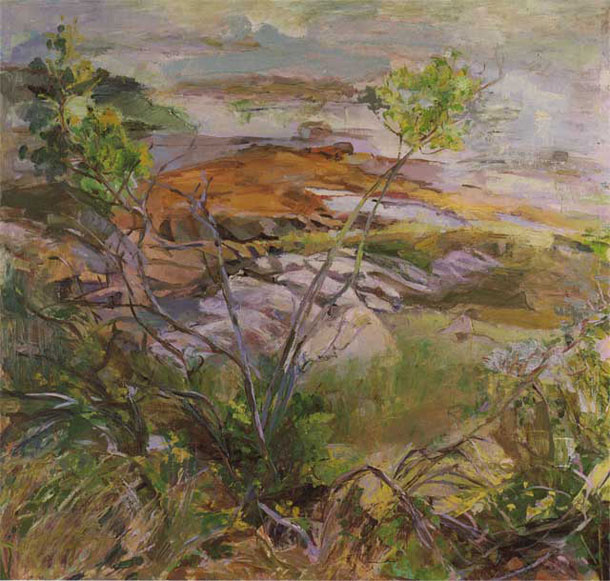
Gretna Campbell “Pink Shore”53 x 56 inches 1983
Gretna Campbell (1922–1987) was a significant painter who mainly painted landscapes, often large and made at least in part from observation. She taught at Yale and was an important influence on many painters in pursuing painting from nature. I became aware of her work through her son’s, Henry Finkelstein, paintings and her husband, Louis Finkelstein’s painting and writings. I spoke with Henry Finkelstein briefly on the phone who gave me permission to post some images of her paintings here that I scanned from a catalog from the (now defunct) Contemporary Realist Gallery in San Francisco. I am also providing the essay (uncredited – presumably written by the gallery director or curator of this 1996 show – possibly Tracy Freedman or Dana DeKalb)
Regretfully, there has been few images of Gretna Campbell’s paintings or information about her available online, this post aims to help offer a few images of her paintings and what information I could find to help make available this important artist’s work to younger painter’s. I also plan to post on Louis Finkelstein with some of his paintings and writings in the near future.
Louis Finkelstein wrote of her:
“…paints again and again familiar themes, reshaping, rediscovering their content in subtle yet telling adjustments. The shoreline of Cranberry Island, Maine, tidal coves, rocks, trees, water and sky are given an intimacy and presence which is… formed out of a specific feeling about the place…. Her color chords and passages of paint…are devoted to the description of emotion, mood, association – involved with meanings discovered in nature through the transformation of painting language. This… kind of painting, by realizing its own nature, takes the physical and psychological reality of the world into itself.”
Gretna Campbell stated:
“I intend to find out something of the nature of the world through seeing.
Or maybe I only intend to prolong my delight in seeing.”
Maureen Mullarkey discussed her work in a 2004 artcritical article in which she said:
Ms. Campbell came of age among a generation of painters respectful of the achievements of Abstract Expressionism but confident that depictions of the natural world remained timely and significant. She was a realist in the best sense, faithful to the physical pulse of what she observed yet not subservient to appearances.
The apparent spontaneity of the work belies the rigorous studio preparation that preceded outdoor painting. Ms. Campbell drew on site, mapping details of the locale: the juncture of planes, the nodal points of her composition. Transferred to canvas, this initial linear schema was painted over in the studio with broad expanses of color chosen for chromatic interaction with the final paint layers improvised on the spot.
The pleasure of her work is in the variety and complexity of its color and the lush, textural weave of brushstrokes. Details of the local scene-a rocky shoreline, the slope of a field or angle of a trellis- are the raw material for a pictorial architecture built on the reciprocal effects of one color upon another. She worked boldly with brush and palette knife but the result is fastidious and transparent. The gestural energy of action painting enlivens an intimate sympathy for natural settings.
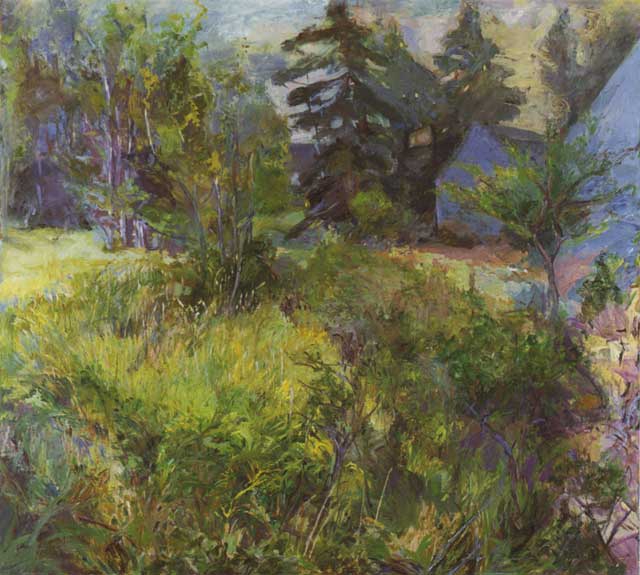
(click for larger view – true for all the images in this article)
“Wild Wheat Field” 1984. Oil on canvas, 66 x 72 inches, Photography courtesy of Henry Finkelstein
From the Contemporary Realist Gallery Catalog:
AT THE HEIGHT of the Abstract Expressionist movement, which has been referred to as the “Triumph of American Painting,”1 a somewhat younger generation of painters, while interested in and often respectful of their predecessors, formed the conviction that an art based on the depiction of the natural world could make a serious and ambitious statement in the latter part of the Twentieth Century. They did not go back to nature because they had never left it. At the same time they felt themselves to be thoroughly modern. Neither did they feel impelled to embrace abstraction which was then widely touted as an historical (or at least fashionable) imperative, because they had in their own ways assimilated its values. Mainly they wanted a more solid, durable and less willful ground under their feet, and they saw that there was plenty of room for it.
Some of them received a great deal of public attention, some less, although for the most part they were well known and esteemed by each other. Such a one was Gretna Campbell (1922-1987) who exhibited throughout this period, but whose work is just beginning to receive the attention it deserves. If her painting fell between various categories (new realism, expressionism, action painting) it was because it was personal, and complex, developing over a long period of time and based upon a knowledge of the traditions of painting that few of her contemporaries had taken the time or effort to absorb, yet in no sense bound within the constraints of the past.
The novelty of her painting, mostly landscape, was that it was large enough to incorporate a solid and specific structure associated with studio painting, but worked out and finished directly on the spot-an approach hitherto linked to the improvised sketch. Her subjects were principally the trees and rocks and shores of coastal Maine, but she also painted in the south of France, Brazil, Northern Connecticut and Western New Jersey. Where others sought out easily codified motifs she looked for the most complex. Where others went after decorative simplifications of form and color, her expression and choices of motifs were dense, tangled, weighty and spatial.
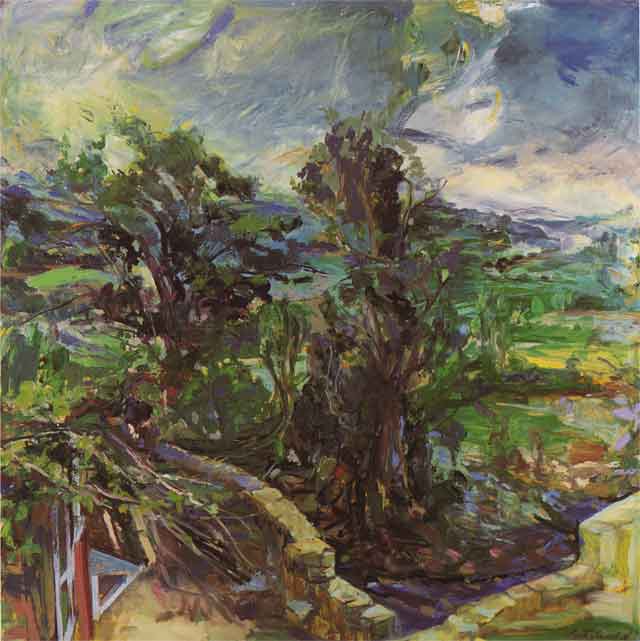
“Norfolk, Tree and Storm” 1977. Oil on canvas, 60 x 70 inches
Campbell’s working process was the reverse of the landscape sketch. Usually she would start with a number of careful linear drawings of the details of a scene, particulars of foliage and rocks and the ways in which local forms articulated one another. These were assembled using only the most rudimentary compositional notes, then enlarged and transferred onto the canvas, retaining all of their specificity. Over this wealth of linear information she would lay in an underpinning of broad areas of color with the drawing showing through. These colors were not the colors of observed nature but rather counter colors for the subsequent upper layers of paint to react against. This procedure fills Campbell’s paintings with subtle vibrations, the nearest comparable expression of which might be the veils, buildups and overlays in Monet’s late Water Lilies.
1 lrving Sandler, The Triumph of American Painting, Praeger Publishers, New York: 1970.
Following this extensive preparation, the canvas was brought to the motif and the work of pulling the details into a coherent composition was carried out directly in the face of nature. This was not aimed, as it was in the case of the Impressionists, with catching the effects of a passing moment of the time of day, but rather at weaving all of the elements into a multiply comprehended environment through which the eye could roam at length. All of this lent Campbell’s paintings a distinctive richness of changing focus and movement in and out of space. Her foregrounds extend intimately close to the observer, and then move far back into the depths of woods, or to a distant horizon. Her unorthodox approach of resolving each composition directly on the spot was daring and dramatic. Although her work incorporates the kind of complex structuring one finds in some old master paintings it is always full of fresh discoveries of scheme and emotional content.
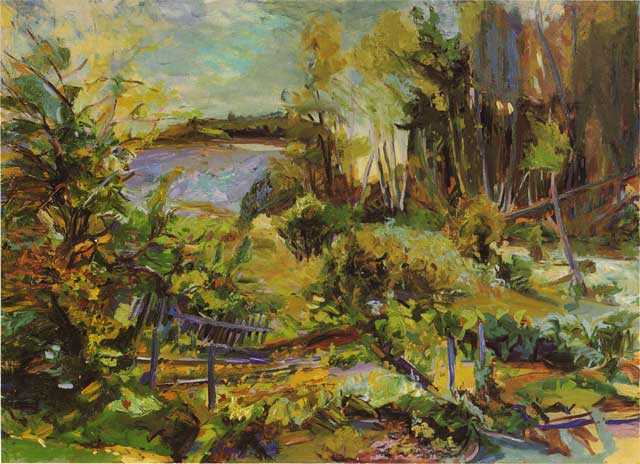
“Garden” 1985. Oil on canvas, 48 x 66 inches
Campbell’s dense layering of paint and complex physical handling, sometimes with a loaded palette knife, sometimes with surprisingly free gestural brushstrokes, led some of her contemporaries to see her applying the process nature of DeKooning, Pollock and Resnick to the aims of realistic description. She was a realist in a deep sense… in the sense of Courbet involved with conveying the weight, mood, and physical presence of the natural world; and beyond Courbet, in the sense of Rembrandt, breaking through the norms of classical Baroque and High Renaissance to an intimacy and surprise with the natural world.
Her color is neither traditionally tonal nor impressionistically or fauvistically intense. Instead, just as with the complexity of her drawing, Campbell invented and improvised a scale of internal differentiations of subtle color intervals: grey greens, reds, pinks, browns and violets, all interweaving. Each element has its appropriate differentiation and yet plays a part in the light, air and spaciousness of the whole. One of her concerns with which few painters of today are involved is for differentiation of focus; never is the picture as a whole seen simultaneously… instead one looks first here, then there, moving through the space. This conveys an intimate sense of being there … not like a snapshot, but rather an extended reverie. Those who appreciate Campbell’s work find it a source for long contemplation.
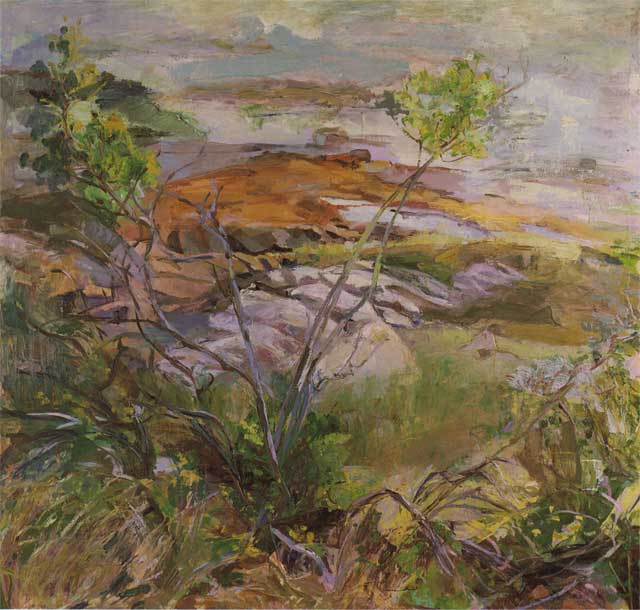
“Pink Shore” 1983. Oil on canvas, 53 x 56 inches
Campbell’s vision could not have been accomplished without the convergence of two factors: the long, deep study of several masters of Western art, and a highly focused and extended working process in nature. The artists she looked to were many. Very early Giotto and Masaccio, then Piero and Bellini. After this Courbet, Cezanne and Constable, Ruysdael, Breughel and Rubens, Van Gogh, Dufy, the Fauves … Renoir, Titian, Veronese, Claude Lorrain, Poussin, Giacometti, Altdofer. More than anyone else, Rembrandt. Her study was not of a particular style or a look, but of underlying principles and ideas of pictorialism. It enriched and in turn was enriched by the many insightful analyses which she incorporated into her teaching. Yet her work never looks over-studied, or in any way cramped or academic. Rather, study continually led Campbell to greater freedom and confidence before her subject: the final result emerges unselfconsciously from the working process, never wholly in view until the final touches.
The paintings in the current exhibition are roughly from the last decade of Gretna Campbell’s career and show the daring, energy and virtuosity she had acquired in the course of her development … the grandness of her landscape scale and her psychological intimacy with the actual scene. In Long View and Norfolk, Tree and Storm, painted in the same year, we see two entirely different landscape schemes, the former from the Delaware River Valley, the latter from Western Connecticut. From the following Spring comes Top of the Hill,Wallpack, grand and breezy. Garden is a complex evocation of the immediate surroundings of her summer home in Maine. Fish Point, Horizon is a poetic fragment of almost the same scene, the exception which proves the rule of her complex intentions. Pink Shore, Rose Bushes, Path Toward Evening and two of her largest, Wild Wheat Field and Rose Bushes on the Shore are all prime examples of the coalescence of her pictorial intelligence and her passion for nature.
The trajectory of Campbell’s development and her body of work exemplify the continued fecundity of the realist impulse, and of a rare talent formed by it, as well as the many pleasures and insights which are made available by the sense of continuity with tradition which constitutes a larger modernism than is yet generally realized.
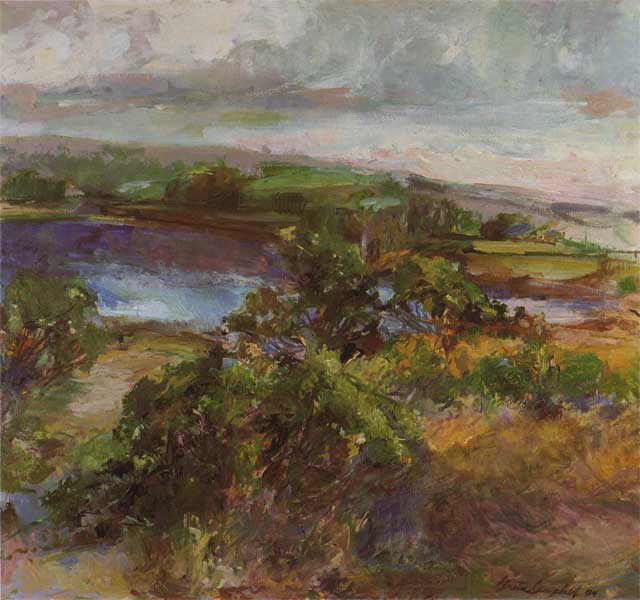
“Rose Bushes” 1984. Oil on canvas, 52 x 56 inches
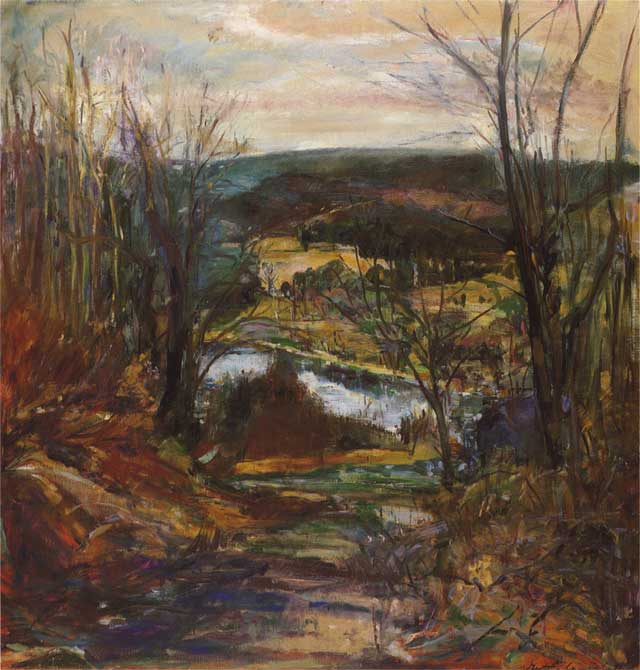
“Long View” 1977. Oil on canvas, 52 x 50 inches
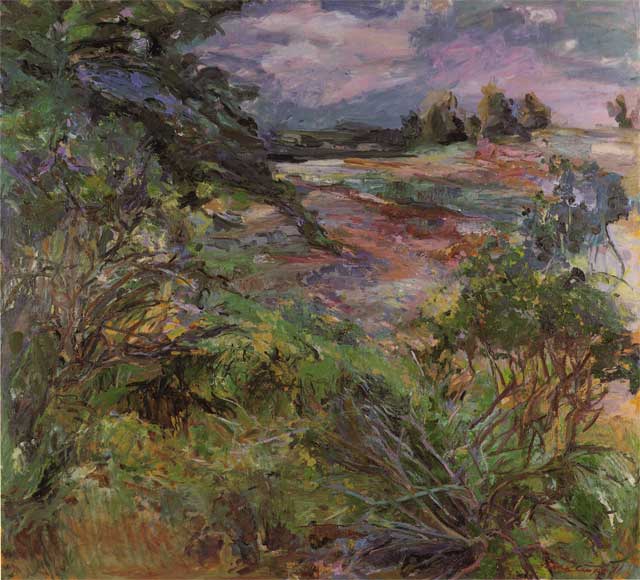
“Rose Bushes on the Shore” 1985. Oil on canvas, 66 x 72 inches
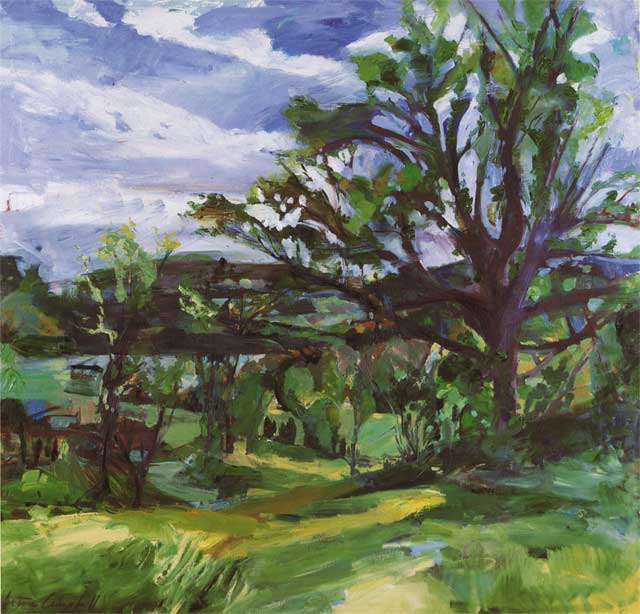
“Top of the Hill, Wallpack” 1978. Oil on canvas, 56 x 58 inches





My little Gretna Campbell story:
Gretna Campbell also taught for a number of years at Maryland Institute College of Art.I started teaching at MICA in the fall of 1973.I wanted to meet her and found out which classroom she taught in. Tip toeing into her class to introduce myself, I heard her talking to one of her students. He had pinned a half dozen of his new drawings to the wall and they were lookng at them together. He had done the drawings on graph paper right over the network of thin red lines. Gretna asked him about this choice. The student said it was the only paper he had available and figured as the grid lines were so faint that it didn’t matter. Gretna paused for a moment and then said to him gently but forcefully “Everything your eye sees ends up influencing you. You can’t afford to ignore anything.” I always liked that. Many times I tell my students the same thing and realize I’m using Gretna’s words.
Thank you for introducing me to the paintings of Gretna Campbell! I am very inspired by this work. I appreciate that I was able to zoom in and see the quality of her paint application. Another great post on this site!
I was introduced to her work through a lecture at American University about twenty years ago. In my opinion, her work is so strong, in part, because it is earned through her complex process of painting and experiencing space. The result of this confrontation is a painting imbedded with her deep intellegence and emotion.
Many moons ago while I was young and a bit shy,I was studying w/ Gretna at the New York Studio School on w. 8th st. in nyc. I remember her kind words and encouraging manner when I needed it most!
Thanks for your comment Diane, Sorry its taken me so long to reply – thanks for your recollection of your study with Gretna Campbell. I’m envious, she sounds like she was a great teacher. If you should remember any of her quotes or anything else, please post a comment with what you remember so we can all benefit.
One thing I remember was one day at a critique at the New York Studio School Gretna held my self-portrait up in defense for me, exclaiming how good it was. It was special to me. She also said other encouraging words about my drawings, saying I drew ears really well! It’s funny to say it now but when I was in the mist of drawing 4 hours from the model and painting 4 hours in the afternoon I appreciated all the encouragement I could get!
Gretna was my first drawing teacher when I was an undergraduate at Yale. I remember her commitment to looking, always bringing the work back to a dialogue with perception. And, of course, her extraordinary patience and generosity with her students.
Dear Larry,
I am in your debt for posting all these images and thoughtful comments about my mother’s work on your site. At present, Gretna’s work needs all the help it can get. May they continue! Also, somehow I didn’t know about the article above by Irving Sandler. I can’t quite tell how much of that text is by him or if it comes from somewhere else. I’m getting a web site of Gretna’s work up soon, (I’m shooting the pictures this week). Is there any chance anyone can send, or inform me, of the whole article? Perhaps I could put that on the site as well.
Forgive me if I sound out of the loop. Through passage of time, even just 24 years since her death, so much gets lost, even for me, her son. So again, bless you for adding to a new awareness of her work which we all know has been greatly underrated.
The conversation between artists through the centuries is such an enigma as it gets buried so quickly. How would Titian have spoken of plasticity fro example? or of Painterly, which he pretty much invented.
Regards,
Henry Finkelstein
Larry,
Hello again. Please forgive my confusion. I now see that the mention of Irving Sandler above is only as a footnote to the text in the Contemporary Realist Gallery catalogue, which make much more sense. I was wondering what to make of that. It seemed really out of place. How stupid of me.
But I still mean it that I greatly appreciate your generating conversation about her work. I was photographing some of her paintings today, mostly landscapes from the 60’s and 70’s and figure paintings. These are both things people will not have seen in a while, and may find surprisingly fresh. I intend to go back and do more, and to get our site up on her soon.
Hi Henry, Thanks for your wonderful comment. It is indeed a shame that so many great artists get lost in history once they pass on. Even the greatest masters are not immune to this. Like Piero who for centuries dropped out of sight of the mainstream. While jpegs seen in a browser is no substitute for the real experience of standing in front of your mother’s magnificent paintings, at least we can give her work exposure to younger painters who perhaps will be inspired by her fresh and inventive manner of painting nature. I will look forward to seeing your website for her when it’s finished and I will be sure to put a link to the site.
Does anyone know where I can get a hold of a catalog of Gretna’s work?
Diane, I got this catalog from Amazon.com for 40.00 I think it was. Bit pricey. What you see here is the entire catalog-the color is marginally better in my catalog and probably truer to the paintings.
Really like these paintings — they’re from scanned printed images? I think the colors would look terrific if they were photographed directly. Hope to see that someday. Thanks!
glad you liked them. Yes they are scanned from a print catalog. Gretna Campbell’s son, Henry Finkelstein, has plans to put together a tribute website for her at some point, perhaps then he’ll make better color reproductions available. I believe he photographed these originally.
I have two works by Gretna Campbell…..
always admired by visitors as well as myself…
We own two of Gretna’s paintings. The larger of the two (Winter at Salamorka) 1978 is 64″x 45″. It was lent to Yale at their request some years ago. It hangs in our dining room.
The second is a bit smaller and is a scene in western New Jersey.
Her work has inspired me to start painting on my own.
Some years ago, we purchased a painting from Sonia Gleneva (?) at a Greenwich Village fair. She told us she had been a student of Henry Finkelstein.
I don’t feel that Gretna was ever accorded the recognition she deserved. Her brush strokes come alive each time I gaze into the painting…because that is what one does…gaze into her vision and her paintings of them.
Ilan Plawker
Gretna was a guest artist at the University of Wisconsin-Oshkosh, I’m guessing back in 1984. As she was conducting a critique, one student pointed out that his/her (I can’t remember) painting was a copy of one of Ms. Campbell’s paintings that he/she did in anticipation of Gretna’s visit. Gretna replied that it didn’t look a bit like anything that she’d done. I’m sure that to the student’s eyes, it was a reasonable likeness to Gretna’s work – however, Gretna could see well beyond the superficial similarity, and it looked unrecognizable to her.
I’d love to know if Gretna Campbell ever painted any Staten Island-based landscapes. I’m curating a show on this theme for 2013 for the Staten Island Museum’s new galleries at Snug Harbor, and would love to include a work by her, if such a work exists.
Robert, I would suggest you speak to Gretna Campbell’s son, the painter Henry Finkelstein, you can get his email and contact information on his website. I believe he has photographed and cataloged most of his mother’s work and would likely know if she ever painted there.
http://www.huffingtonpost.com/john-seed/janice-nowinski_b_1511997.html
Interesting article here in the Huffpo about the painter Janice Nowinski, former student of Gretna Campbell…
Janice’s show lead me to this post. I am happy I found it as Gretna was an amazing painter and teacher. And as Gretna stories are beeing collected here, I’d like to add one of my favorites.
This happened in the first weeks of my first term at the NYSS. The model was taking a break and Gretna had us all sit on the floor in front of her to look at a book with a Marquet flag painting. She was on a chair and said (as she pointed), “Here’s a blue, here’s a blue, here’s a blue. See how they make a triangle?” I thought, here I’ve gone all the way through college and I’m back in kindergarden learning my shapes…
The thing is, that was one great triangle and it served me well. With that concept Gretna began teaching me (us) about a whole new level of painting. How lucky we were to have her to pass that information on.
I recently posted a blog about Gretna Campbell at Bowerygallery.wordpress.com. Many Bowery members studied with Gretna at the NYSS and Yale and at Philadelphia College of Art and they share their fond memories, plus there are many good paintings. Many thanks to Henry Finkelstein for supplying these images.
Here is the link:
https://bowerygallery.wordpress.com/2016/09/22/gretna-campbell-artist-and-teacher/
I invite everyone to read the Bowery blog
on our blog I included a link to Painting Perceptions but didn’t realize that this site allows comments. How wonderful to read.
oops–i just noticed the typos.. can i correct my comment?
yes i was there then.
Gretna was a unique character with a Dedication to getting to the stage in her paintings where each part expressed a sense of the particular and at the same time became a unique part of a synthesis of the whole composition
Her color is strongly felt and her physicality of the paint makes the painting vibrant with her touch There’s nothing in her work that seems perfunctory as she digs into the picture and the sensation that is informing her
I’m very fortunate women live with her work ( and some of Louis’ paintings too)
We need a monograph on her work as a way to secure her proper place in painting She is a force to be reckoned with
Sadly I didn’t get to study with Gretna yet at PCA I was in a painting class next to her class and just a heavy canvas curtain divided the 2 studios I heard her comments to her students and it spoke volumes to me too
I was a student of Gretna Campbell at Yale while doing a Master’s of Divinity Degree, (I later did a Master’s of Fine Art Degree). Gretna Campbell showed me such a generosity of spirit in talking about my drawings. I was shy about my drawings as I had none of the formal training that others in the class had at that time…rather…I had none and I worked hard to improve and to keep up. What I did do though was drive my huge old 67 Dodge Station Wagon out to Long Wharf and do drawings at night of boats in relationship to lights and the pier. Gretna Campbell would say few words but her comments were exacting. She said to me, ” See these three points…these three lights you’ve made specific in this drawing at night? They set up the whole drawing and make it work….lights against the dark.”. Well I was blown away by that comment…for two reasons…one being that I had grown up around a pier at my father’s river taxi on the Delaware near Philadelphia and secondly…that I was doing something very quickly and spontaneously in the front of my old station wagon that seemed not very studio like for Yale and here I was being complimented. It was at a gallery opening of other artists at Bert’s Walkers Gallery in Provincetown that I asked Paul Resika in 2022 if he knew Gretna Campbell. Resika laughed and said enthusiastically…”Yes of course I knew her quite well…and remember her riding her bicycle with a large canvas strapped to her back going out to paint. The canvas was larger than she was but she was determined. Wonderful big paintings of Nature.” I was so filled with joy to hear this from Paul Resika. Her comments to me in the drawing class now made more complete sense. It was the process of going out….into nature…not confined to a studio environment…that resonated with her. So my old station wagon drawings done in the front seat in the rain in the dark by the pier at Long Wharf in New Haven had been an avenue for her to tell me…you have something here…hold on to it.